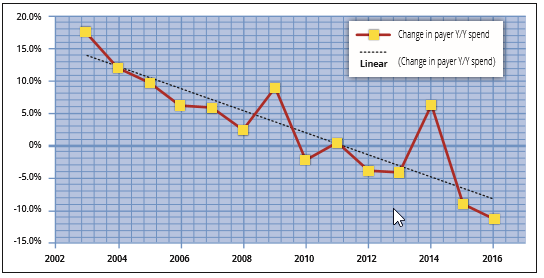According the Centers for Medicare and Medicaid Services’ Office of the Actuary (OACT), in 2016 the U.S. spent $328.6 billion on prescription drugs, or 10% of all health care spending. We also see that prescription drug spending increased 1.3% to $328.6 billion in 2016, slower than the 8.9% growth in 2015.
These trends towards more spending on prescription drugs, however, is not homogenous throughout the economy. Take a look at the graph below looking at pharmacy spending growth among workers compensation plans. As detailed in a report by Joe Paduda of CompPharma, we see that prescription drug spending is actually falling among those covered by workers compensation plans.

Joe gives some highlights in his Managed Care Matters blog as well:
2017 drug spend dropped 13.4 percent from 2016 – the biggest decrease in the 15 years we’ve been doing the survey
Opioid spend decreased twice as much – over 26 percent.
Note that the huge drop in opioid spend occurred BEFORE adoption of formularies and other controls in big states like Pennsylvania, New York and California.Note also that this is the sixth drop in drug spend since 2010.
In short, while drug spending is increasing, but perhaps decelerating in the economy as a whole, workers comp actually has seen a large drop in prescription drug spending, particularly for opioids.
THE OPIOID EPIDEMIC IS IN ALL THE NEWS. In the US last year, opioids (including prescription opioids, heroin, and fentanyl) killed more than 42,000 people, more than any year on record. 40% of all opioid overdose deaths involve a prescription opioid (report by CDC). I recently wrote two blogs on opioids: One about a family struggling with a son’s addiction (click HERE), and the second a horrendous story about two opioid addicts but with a positive ending (click HERE).